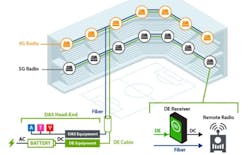VoltServer: Fault Managed Power is a Technological Bridge to Wireless Networks
Key Highlights
- FMP enables safe, scalable power delivery over long distances without the need for extensive wiring or conduit installation.
- Compared to PoE, FMP offers higher capacity and greater transmission distances, making it ideal for expanding wireless device networks.
- The technology includes fault detection and automatic shutoff, reducing electrical hazards and simplifying installation without licensed electricians.
- FMP's remote monitoring and control capabilities allow for efficient energy management and easy device relocation.
- VoltServer's Tetra platform represents the latest in FMP innovation, supporting future-ready wireless infrastructure development.
A recent statement from VoltServer makes a compelling case for the use of fault managed power (FMP) in a number of wireless applications, saying the powering technology is a bridge to wireless growth.
“Homes are now filled with wireless speakers, thermostats, and appliances,” the company says, describing the omnipresence of wireless devices in many aspects of society. “Hospitals use a wide range of wireless patient monitors and connected medical devices. In classrooms, students and teachers rely on tablets and laptops. Manufacturing plants optimize production based on sensors, trackers, and control systems—all wireless … As wireless connectivity expands, the way these devices are powered must change as well.”
The delivery of safe, reliable, scalable power to the proliferation of wireless devices is becoming a bottleneck, the company emphasizes. “Supporting this density and effectively extending traditional power to every location where wireless devices are needed can quickly become unsustainable in terms of logistics and costs.”
The case to be made for FMP as a power source to wireless devices such as access points, sensors, cameras, light fixtures, alarms, and access control systems, is similar to that made for Power over Ethernet (PoE), which has been widely adopted for more than two decades. The benefits of both include the ability to quickly and safely install a power source to remote, difficult-to-access locations. “Extending traditional power infrastructure to every new device location would require installing new conduit, pulling wire, and upgrading panels—which dan be costly, disruptive, and slow,” VoltServer points out.
So why is FMP a preferred solution to these issues when PoE can make similar claims? In two words: distance and capacity. VoltServer explains, “Delivering low-voltage PoE leads to significant power loss over long distances, meaning many devices may not receive the power they need to operate … The answer to these challenges lies in remote power’s ability to deliver electrical power to devices that are positioned far from a central power source and outlet. PoE … enables power and data to be delivered over a single Ethernet cable. But it also has its limitations, including restricted power capacity and limited transmission distance.
“FMP takes a scalable, safe, and flexible approach to remote power delivery. It’s the bridge between the limitations of traditional power and the demands of wireless connections. FMP enables the safe transmission of significant power over long distances using standard cabling. This makes it straightforward to add or relocate devices as needs change.”
FMP’s built-in fault detection and automatic shutoff greatly reduce the risk of electrical hazards, VoltServer adds. FMP does not require licensed electricians for installation, and involves fewer materials; it does not require conduit, circuit breakers, or panels, for example.
Fault managed power’s versatility and ease of modification make the technology particularly attractive for wireless device networks, VoltServer stresses, pointing out the following characteristics of FMP-powered wireless devices.
- They can easily be added or relocated without major rewiring.
- Power can be delivered to them across hundreds of meters without significant loss.
- Power delivery to them can be monitored and controlled remotely and integrated with building management systems to optimize energy use and improve operational efficiency.
“As more wireless devices are deployed, FMP can safely and efficiently deliver necessary power to them without worrying about the limitations of PoE or the risks and costs associated with traditional power distribution,” the company says, concluding that deploying FMP “not only removes barriers to wireless expansion, but also lays the foundation for safer, more-efficient, and future-ready infrastructure."
Last fall VoltServer introduced Tetra, its third-generation FMP platform. You can find out more about Tetra and FMP technology in general here.
Shortly before VoltServer introduced Tetra, we spoke with the company's chief revenue officer Ronna Davis about the capabilities of fault managed power.

